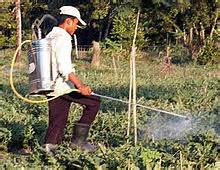 A weed is simply a plant growing where it is not welcome. Weeds can cause a decline in the aesthetic quality of a lawn or they might severely damage the yield potential of an economically important crop. Some weeds may even pose a health risk to one’s livestock. The most common method used to control weeds is with herbicides largely because it is the expedient method. Efficiency can come at a cost in the form of weeds developing resistance to the herbicides that were once used to control them. Weed resistance is when a chemical that was previously effective at controlling a weed is no longer as effective.
A weed is simply a plant growing where it is not welcome. Weeds can cause a decline in the aesthetic quality of a lawn or they might severely damage the yield potential of an economically important crop. Some weeds may even pose a health risk to one’s livestock. The most common method used to control weeds is with herbicides largely because it is the expedient method. Efficiency can come at a cost in the form of weeds developing resistance to the herbicides that were once used to control them. Weed resistance is when a chemical that was previously effective at controlling a weed is no longer as effective.
When a weed develops resistance to an herbicide this can cause significant damage to many agricultural operations due to significantly increased control costs and lost time. Unmanaged weeds can also result in decreased harvest efficiency, lower crop yield, and decline in crop quality.
Resistance occurs when a weed’s genetic makeup slightly changes randomly when reproducing and these slight changes allow for the weed to become resistant to an herbicide. The most common mechanisms that allow for a plant to resist an herbicide are an alerted target site, enhanced metabolism, compartmentalization, and over-expression of a target site. An altered target site occurs when an herbicide’s active ingredient (chemical) can no longer bind to a specific part of a weed’s chemical pathways. Enhanced metabolism occurs when a plant can break down or degrade an herbicide before it can be affected. Compartmentalization happens as a result of a plant preventing an herbicide from affecting the weed by storing or removing the herbicide from susceptible parts of the plant. Over-expression of a target site occurs when a plant generates such large quantities of a target site that the herbicide’s effectiveness is greatly reduced.
To make matters worse weeds can, and in numerous instances already have, developed multiple resistance and cross resistance. Multiple resistance is when a weed is resistant to two or more herbicides that have different mechanisms of action. In other words, multiple resistance is when a plant is able to resist two or more herbicides that affect the plant in different ways. Cross resistance is more common and occurs when a weed is resistant to two different herbicides that share the same mechanism of action.
Fortunately, there are simple steps that can be taken to greatly reduce the chances of a weed population possessing herbicide resistant characteristics. The most effective method is to rotate the herbicides that are used to control weeds. Many herbicides of different brand names share identical active ingredients, so it is not reliable to change herbicides merely based on its name. What should be used when making a choice to rotate to another herbicide is its WSSA Group number. The WSSA Group is a system of herbicide classification created by the Weed Science Society of America. WSSA Group numbers are significantly different from other WSSA Group numbers to allow for a successful herbicide rotation to occur to prevent weed resistance issues.
Another fundamental method of managing weed resistance issues is to carefully read each herbicide product label. Herbicide labels will provide the user with every important piece of information they need to use the product safely and effectively. Not only is it just a good idea to follow the label, it’s the law! This helps not only with safety and environmental sustainability; it helps to stomp out those pesky weeds.
For more information on weed resistance and related topics please contact the Marion County Extension office at 352-671-8400.
 1
1
